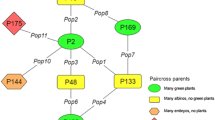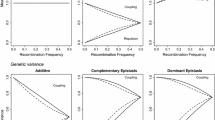Abstract
For in vivo production of doubled haploid (DH) lines in maize, the rate of haploid induction is of crucial importance. Maternal haploid induction depends primarily on the inducer used as a pollinator. However, the source germplasm used as a maternal parent and the environmental conditions for induction may also influence haploid induction and these aspects have not been examined in tropical maize so far. The objectives of our study were to (i) monitor the variation for haploid induction rate (HIR) among diverse source germplasm in tropical maize, (ii) determine the relative importance of general (GCA) and specific (SCA) combining abilities for HIR, and (iii) investigate the influence of summer and winter seasons and genotype × season interactions on this trait. Ten inbreds were mated in a half diallel design. The resulting 45 F1 single crosses were pollinated with the haploid inducer hybrid RWS × UH400 during the summer 2008 and winter 2009 seasons in a lowland tropical environment in Mexico. HIR of the single crosses averaged over seasons ranged from 2.90 to 9.66% with an overall mean of 6.74%. Mean HIR was significantly (P < 0.01) higher during the winter (7.37%) than summer season (6.11%). Significant (P < 0.01) variation was observed due to GCA effects of parental inbreds of single crosses but not for SCA, GCA × season and SCA × season interactions. Our study underpins that a higher HIR in tropical maize can be obtained by selecting appropriate source germplasm and undertaking pollination under favorable environmental conditions.


Similar content being viewed by others
References
Aman MA, Sarkar KR (1978) Selection for haploidy inducing potential in maize. Indian J Genet 38:452–457
Belicuas PR, Guimaraes CT, Paiva LV, Duarte JM, Maluf WR, Paiva E (2007) Androgenic haploid and SSR markers as tool for the development of tropical maize hybrids. Euphytica 156:95–102
Bouchez A, Gallais A (2000) Efficiency of the use of double-haploid in recurrent selection for combining ability. Crop Sci 40:23–29
Chalyk S (1999) Creating new haploid-inducer lines of maize. Maize Genet Coop Newsl 73:53–54
Chase SS (1952) Production of homozygous diploids of maize from monoploids. Agron J 44:263–267
Chase SS (1969) Monoploids and monoploid-derivatives of maize (Zea mays L.). Bot Rev 35:117–168
Coe EH (1959) A line of maize with high haploid frequency. Am Nat 93:381–382
Coe EH (1962) Spontaneous mutation of the aleurone color inhibitor in maize. Genetics 47:779–783
Dhillon BS, Paul C, Zimmer E, Gurrath PA, Klein D, Pollmer WG (1990) Variation and covariation in stover digestibility traits in diallel crosses of maize. Crop Sci 30:931–936
Eder J, Chalyk S (2002) In vivo haploid induction in maize. Theor Appl Genet 104:703–708
Fan JB, Gunderson KL, Bibikova M, Yeakley JM, Chen J, Wickham Garcia E, Lebruska LL, Laurent M, Shen R, Barker D (2006) Illumina universal bead arrays. Methods Enzymol 410:57–73
Geiger HH (2009) Double haploids. In: Bennetzen J, Hake S (eds) Handbook of maize—genetics and genomics. Springer Science + Business Media, LLC, New York, pp 641–657
Gordillo GA, Geiger HH (2008) Optimization of DH-line based recurrent selection procedures in maize under a restricted annual loss of genetic variance. Euphytica 161:141–154
Griffing B (1956) Concept of general and specific combining ability in relation to diallel crossing systems. Aust J Biol Sci 9:463–493
Lashermes P, Beckert M (1988) Genetic control of maternal haploidy in maize (Zea mays L.) and selection of haploid inducing lines. Theor Appl Genet 76:405–410
Liu K, Muse SV (2005) PowerMarker: an integrated analysis environment for genetic marker analysis. Bioinformatics 21:2128–2129
Mayor PJ, Bernardo R (2009) Genomewide selection and marker-assisted recurrent selection in doubled haploid versus F2 populations. Crop Sci 49:1719–1725
Melchinger AE, Lee M, Lamkey KR, Woodman WL (1990) Genetic diversity for restriction fragment length polymorphisms: relation to estimated genetic effects in maize inbreds. Crop Sci 30:1033–1040
Mode CJ, Robinson HF (1959) Pleiotropism and genetic variance and covariance. Biometrics 15:518–537
Nanda DK, Chase SS (1966) An embryo marker for detecting monoploids of maize (Zea mays L.). Crop Sci 6:213–215
Pickering RA (1984) The influence of genotype and environment on chromosome elimination in crosses between Hordeum vulgare L. X Hordeum bulbosum L. Plant Sci Lett 34:153–164
Pickering RA, Morgan PW (1985) The influence of temperature on chromosome elimination during embryo development in crosses involving Hordeum spp., wheat (Triticum aestivum L.) and rye (Secale cereale L.). Theor Appl Genet 70:199–206
Röber FK, Gordillo GA, Geiger HH (2005) In vivo haploid induction in maize—performance of new inducers and significance of double haploid lines in hybrid breeding. Maydica 50:275–283
Rogers JS (1972) Measures of genetic similarity and genetic distance. In: Studies in genetics VII. University of Texas Publication 7213, Austin, pp 145–153
Royston JP (1982) An extension of Shapiro and Wilk’s W test for normality to large samples. Appl Stat 31:115–124
Saitou N, Nei M (1987) The neighbor-joining method: a new method for reconstructing phylogenetic trees. Mol Biol Evol 4:406–425
Sarkar KR, Pandey A, Gayen P, Mandan JK, Kumar R, Sachan JKS (1994) Stabilization of high haploid inducer lines. Maize Genet Coop Newsl 68:64–65
Scheffé H (1959) The analysis of variance. John Wiley & Sons, New York
Schmidt W (2004) Hybridmaiszüchtung bei der KWS SAAT AG. (In German) In: Bericht über die 54. Tagung der Vereinigung der Pflanzenzüchter und Saatgutkaufleute Österreichs 2003, Gumpenstein, pp 1–6
Seitz, G (2005) The use of doubled haploids in corn breeding. In: Proceedings of the forty first annual Illinois corn breeders’ school 2005, Urbana-Champaign, Illinois, pp 1–8
Shatskaya OA, Zabirova ER, Shcherbak VS, Chumak MV (1994) Mass induction of maternal haploids in corn. Maize Genet Coop Newsl 68:51
Singh D (1973) Diallel analysis for combining ability over several environments: II. Indian J Genet 33:469–481
Snedecor GW, Cochran WG (1989) Statistical methods, 8th edn. Iowa State University Press, Iowa
Zhang Y, Kang MS, Lamkey KR (2005) DIALLEL-SAS05: a comprehensive program for Griffing’s and Gardner–Eberhart analyses. Agron J 97:1097–1106
Acknowledgments
This research was funded by the Bill and Melinda Gates Foundation, the Eiselen-Foundation (Ulm), Germany, and BMZ (Bundesministerium für wirtschaftliche Zusammenarbeit und Entwicklung) through the DTMA (Drought Tolerant Maize for Africa), project number—45783.01 and AMS (African Maize Stress), project number—06.7860.7-001.00 projects, respectively. Thanks are due to Dr J. Crossa for help in the statistical analyses.
Author information
Authors and Affiliations
Corresponding author
Additional information
A. Z. Kebede and B. S. Dhillon contributed equally to this work.
Rights and permissions
About this article
Cite this article
Kebede, A.Z., Dhillon, B.S., Schipprack, W. et al. Effect of source germplasm and season on the in vivo haploid induction rate in tropical maize. Euphytica 180, 219–226 (2011). https://doi.org/10.1007/s10681-011-0376-3
Received:
Accepted:
Published:
Issue Date:
DOI: https://doi.org/10.1007/s10681-011-0376-3




